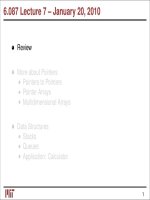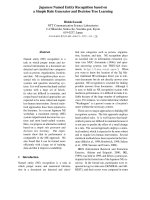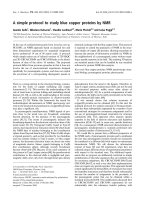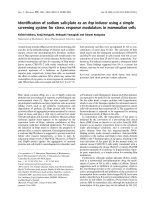A simple calculator
Bạn đang xem bản rút gọn của tài liệu. Xem và tải ngay bản đầy đủ của tài liệu tại đây (237.98 KB, 44 trang )
6.087 Lecture 7 – January 20, 2010
Review
More about Pointers
Pointers to Pointers
Pointer Arrays
Multidimensional Arrays
Data Structures
Stacks
Queues
Application: Calculator
1
Review: Compound data types
•
struct
- structure containing one or multiple fields, each with
its own type (or compound type)
•
size is combined size of all the fields, padded for byte
alignment
•
anonymous or named
•
union
- structure containing one of several fields, each with
its own type (or compound type)
•
size is size of largest field
•
anonymous or named
Bit fields - structure fields with width in bits
•
•
aligned and ordered in architecture-dependent manner
can result in inefficient code
•
1
Review: Compound data types
•
Consider this compound data structure:
struct fo o {
short s ;
union {
i n t i ;
char c ;
} u ;
unsigned i n t f l ag _ s : 1;
unsigned i n t fl a g _ u : 2 ;
unsigned i n t bar ;
} ;
•
Assuming a 32-bit x86 processor, evaluate
sizeof(struct foo)
2
Review: Compound data types
•
Consider this compound data structure:
struct fo o {
short s ;
← 2 bytes
union {
← 4 bytes,
i n t i ;
4 byte-aligned
char c ;
} u ;
unsigned i n t f l ag _ s : 1;
bit fields
unsigned i n t fl a g _ u : 2 ;
←
unsigned i n t bar ;
4 bytes,
←
} ;
4 byte-aligned
•
Assuming a 32-bit x86 processor, evaluate
sizeof(struct foo)
2
Review: Compound data types
•
How can we rearrange the fields to minimize the size of
struct foo
?
3
Review: Compound data types
•
How can we rearrange the fields to minimize the size of
struct foo
?
•
Answer: order from largest to smallest:
struct fo o {
union {
i n t i ;
char c ;
} u ;
unsigned i n t bar ;
short s ;
unsigned i n t f l ag _ s : 1;
unsigned i n t f l a g _ u : 2 ;
} ;
sizeof(struct foo)
= 12
3
Review: Linked lists and trees
•
Linked list and tree dynamically grow as data is
added/removed
•
Node in list or tree usually implemented as a
struct
•
Use malloc(), free(), etc. to allocate/free memory
dynamically
•
Unlike arrays, do not provide fast random access by index
(need to iterate)
4
6.087 Lecture 7 – January 20, 2010
Review
More about Pointers
Pointers to Pointers
Pointer Arrays
Multidimensional Arrays
Data Structures
Stacks
Queues
Application: Calculator
5
Pointer review
•
Pointer represents address to variable in memory
•
Examples:
int ∗pn;
– pointer to int
struct div_t ∗ pdiv;
– pointer to structure div_t
•
Addressing and indirection:
double p i = 3.1 41 59;
double
∗ ppi = &p i ;
p r i n t f ( "pi = %g\n" ,
∗ ppi ) ;
•
Today: pointers to pointers, arrays of pointers,
multidimensional arrays
5
Pointers to pointers
•
Address stored by pointer also data in memory
•
Can address location of address in memory – pointer to
that pointer
i nt n = 3 ;
i nt
∗pn = &n ; / ∗ p o i nt e r to n ∗ /
i nt
∗∗ppn = &pn ; / ∗ p o i n t e r to address of n ∗ /
•
Many uses in C: pointer arrays, string arrays
6
Pointer pointers example
What does this function do?
•
void swap ( in t ∗∗a , i n t ∗∗b ) {
i nt
∗temp = ∗a ;
∗a = ∗b ;
∗b = temp ;
}
7
Pointer pointers example
What does this function do?
•
void swap ( i n t ∗∗a , i n t ∗∗b ) {
i nt
∗temp = ∗a ;
∗a = ∗b ;
∗b = temp ;
}
•
How does it compare to the familiar version of swap?
void swap ( i n t ∗a , i n t ∗b ) {
i nt temp =
∗a ;
∗a = ∗b ;
∗b = temp ;
}
7
Pointer arrays
•
Pointer array – array of pointers
int ∗arr [20];
– an array of pointers to int’s
char ∗arr[10];
– an array of pointers to char’s
•
Pointers in array can point to arrays themselves
char ∗strs [10];
– an array of char arrays (or strings)
8
Pointer array example
•
Have an array
int arr [100];
that contains some numbers
•
Want to have a sorted version of the array, but not modify
arr
•
Can declare a pointer array
int ∗ sorted_array[100];
containing
pointers to elements of arr and sort the pointers instead
of the numbers themselves
•
Good approach for sorting arrays whose elements are very
large (like strings)
9
Pointer array example
Insertion sort:
/ ∗ move p r e v ious elements down u n t i l
i n s e r t i o n p oi n t reached ∗ /
void s hi f t _ e le m e nt ( unsigned i n t i ) {
i n t
∗ pvalue ;
/ ∗ guard a g a in s t going o ut s i de ar r a y ∗ /
for ( pvalue = sor t e d _ a rr a y [ i ] ; i &&
∗ s o r t e d _a r ra y [ i −1] > ∗ pvalue ; i −−) {
/ ∗ move p o i n t e r down ∗ /
s o r t e d _a r r ay [ i ] = s o rt e d _a r r ay [ i − 1] ;
}
s o r t e d _a r r ay [ i ] = pvalue ; / ∗ i n s e r t p o i n t e r ∗ /
}
10
Pointer array example
Insertion sort (continued):
/ ∗ i t e r a t e u n t i l out −of −o r d er element found ;
s h i f t the element , and con t i n u e i t e r a t i n g
∗ /
void i n s e r t i o n _ s o r t ( void ) {
unsigned i n t i , l e n = ar r a y_ le ng th ( a r r ) ;
for ( i = 1 ; i < l e n ; i ++)
i f (
∗ sor t e d _ a rr a y [ i ] < ∗ s o r t ed _ a rr a y [ i −1])
s h if t _ e l em e nt ( i ) ;
}
11
String arrays
•
An array of strings, each stored as a pointer to an array of
chars
•
Each string may be of different length
char s t r 1 [ ] = "hello" ; / ∗ l e n g th = 6 ∗ /
char s t r 2 [ ] = "goodbye" ; /
∗ l en gt h = 8 ∗ /
char s t r 3 [ ] = "ciao" ; /
∗ l en gt h = 5 ∗ /
char s t r A r r a y [ ] = { s t r 1 , str 2 , s t r 3 } ;
∗
•
Note that
strArray
contains only pointers, not the characters
themselves!
12









